Typhoon Haiyan: Still mourning and trying to survive in Tacloban
- Published
Rupert Wingfield-Hayes spoke to Gustavo Cavera of Save the Children in Tacloban
In the middle of Tacloban the McDonalds fast food joint is back in business, and it is jammed.
The last time I was here it was boarded up, everything smashed by the huge wave that swept up the bay ahead of Typhoon Haiyan.
They still don't have French fries and the quarter pounders seems to be lacking lettuce and tomato. But no one is complaining as they gobble up the hot beef patties.
On the road to the airport the huge Robinsons mall is jammed too.
The day I arrived a year ago it was being systematically looted. So was the nearby rice mill. That too is back in business.
The airport terminal has a new roof and new glass in the windows. The runway is getting new asphalt.
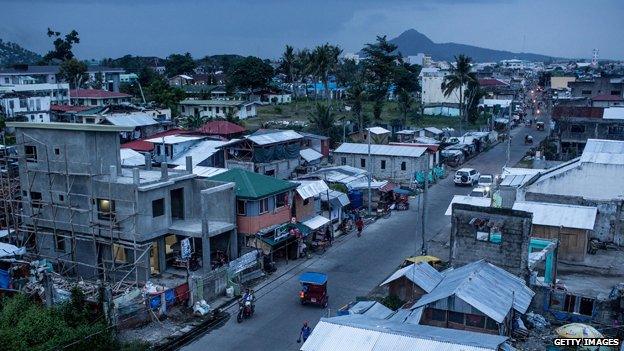
There is a rush to get it finished. The rumour in town is that Pope Francis is coming to Tacloban early in the new year. Everything needs to be spick and span for the pontiff.
But the sense of "normality returned" is deceptive.
The biggest storm ever recorded to make landfall tore apart families, took mothers from their children, children from their parents, and in minutes swept away what had taken a lifetime to build.
It hit the poorest and the most vulnerable hardest.
'Reason to live'
When I last came to Tacloban in the spring Arnel was almost suicidal.
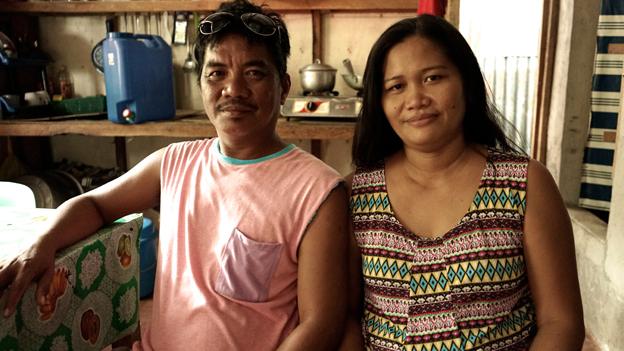
Arnel is expecting a baby with his new partner now
The wave had taken his whole family; wife, two daughters and son. He sat on a chair in his makeshift home staring out of the window. He drank to dull the pain.
Today Arnel looks transformed. He has put on weight and is looking for a job. Most important he has a new partner and a new baby on the way.
When I ask him how he is doing he turns and pats his girlfriend's belly.
"This is what gives me a reason to live again." he says smiling, "soon I will have someone to call me papa again".
On the wall hang a few rescued photos of his wife and children.
"How will you be on Saturday?" I ask, "on the anniversary?"

Housing projects have helped rebuild some homes but thousands still live in make-shift accommodation
He looks up at the photos and the smile slips from his face. Huge tears well up in his eyes and roll down his face.
"My eldest daughter would have graduated from high school this summer," he says, "I dream about seeing her in her gown and hat. When I hear children coming up the street I still look out hoping it is them coming home".
This sort of pain does not just disappear. Life carries on, people learn to live with it, but the heartache endures.
Survivors' guilt
At a nearby UK-funded school run by Save the Children, a young woman in a bright red boiler suit is wielding a welding torch.
The arc welder pops and crackles as she melts two heavy bits of steel together. Geovelyn turns and lifts the heavy black welding mask from her face. She smiles, her big eyes shining.
When the storm hit, Geovelyn was far away at college studying to be a teacher. It took her a week to get home.
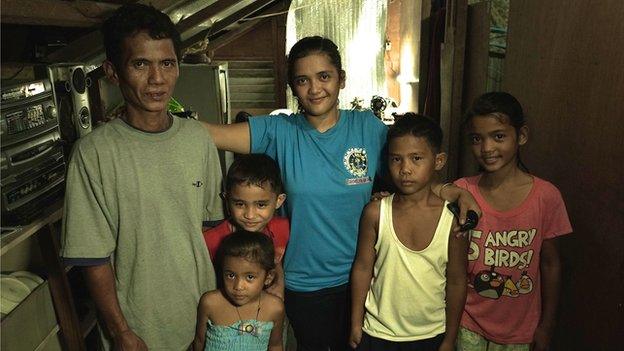
Geovelyn (centre) now supports her father and siblings who survived the storm
When she did she found her mother and three of her sisters were dead. The house was gone and her father and seven surviving siblings had nowhere to live.
"I wish I had never gone away to college," Geovelyn tells me. "If I had been here maybe I could have helped save them".
Rupert Wingfield-Hayes spoke to Leonilo Escalada of Habitat for Humanity in Tacloban
Such survivors' guilt is common here.
"I will not leave again," Geovelyn says, "now I must stay here to support my father and my younger siblings. That is why I am learning to weld, so I can get a job and earn money".
Geovelyn's family is so poor she and her mother would often go out and wash clothes just to get enough cash to buy rice for dinner. Now she has to do it alone.
Leyte province was already one of the poorest parts of one of the poorest countries in Asia. Typhoon Haiyan has pushed hundreds of thousands further into poverty.
Hiding the pain
Jovita is a small woman with greying hair and a cherubic smile. She is not among the poorest in Tacloban.
She is a teacher at a local elementary school. Her husband is a security guard.
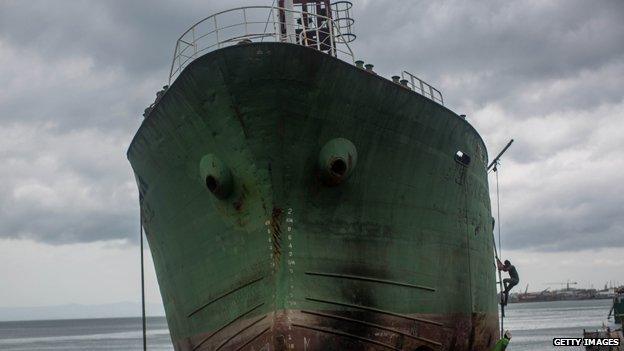
Entire ships were washed ashore with the strength of the storm
Before the storm they even had a concrete house. But the storm surge swept a huge ship through their neighbourhood which crushed their house. It is still stuck on the hillside nearby.
Where Jovita's house used to be there is now a large shack made of wood and scrap pieces of tin and tarpaulin.
"This is how we live now," she tells me, "this is our bedroom and kitchen and living room, all in one".
In the middle there is a plastic table and stools, a wooden bed and mosquito net.
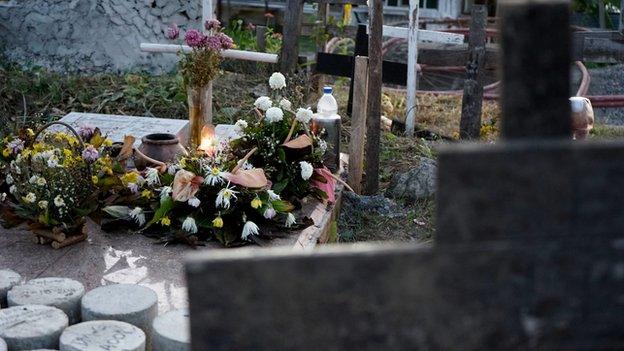
More than 6,000 people died when Haiyan swept through central Philippines
"I got a loan from the government to buy the basics, a few bits of furniture and clothes for the children."
"A loan?" I ask surprised.
"Yes a loan," she says. "They promised cash payment for people who lost their homes, but it has not come."
Before the typhoon Jovita was already in debt. She had been sick and in hospital for weeks. She had to take a loan to pay for the treatment.
Rupert Wingfield-Hayes speaks to Tacloban resident Jovita Mantua who is still living in a temporary shelter
"I don't know how I am going to pay those old loans," she says, "so there is no way I can take a new loan to buy materials to rebuild the house."
While she tells me all this the smile never slips from her face.
"How is it that you keep smiling?" I ask
Suddenly her face crumples and she starts to cry.
"The smile is a mask we wear to hide the pain we have inside," she says, sobbing.